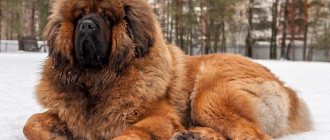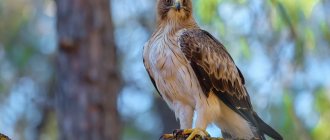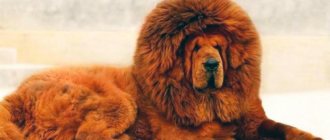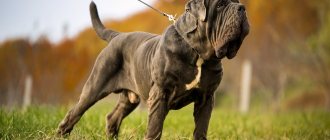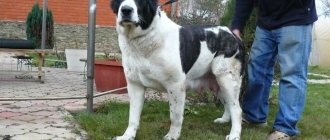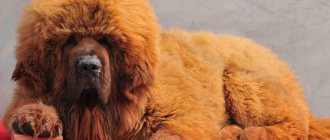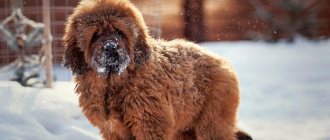Mastiffs are the name of a group that includes a large number of breeds.
It includes such varieties as Major, Spanish, Brazilian, Neapolitan, Pakistani, South African, English and other mastiffs.
The Tibetan Mastiff is one of the earliest dog breeds.
Previously, these animals were used to guard herds of sheep and houses.
In addition to having an interesting history, these dogs have an impressive appearance and are quite large in size.
The record holder for its size was a dog named Hong Dong.
Care and maintenance
Huge size and long hair - this is why caring for a Tibetan mastiff takes so much effort and time. The dog’s thick coat, which has a dense undercoat, deserves special attention. Despite the fact that representatives of the breed rarely develop tangles, regular brushing is still necessary. It is carried out no more than three times a week, using a metal brush. Before combing, it is recommended to spray the hair with diluted conditioner or water: this will make the procedure a little easier.
Don't forget to take care of your Tibetan Mastiff's coat!
If you do find tangles - they mainly appear on the animal’s ears, neck and hind legs - use a tangle cutter and a special spray to gently remove them
Please note that Tibetan mastiffs shed profusely in spring and autumn, so additional devices may be used - a furminator or a slicker
It is strictly forbidden to shorten a dog's fur using a hair clipper! This is fraught with impaired thermoregulation and, consequently, frequent pneumonia.
The Mastiff is not a breed that needs regular bathing. To maintain cleanliness, it is enough to give the animal a bath day once every three months. In addition, frequent water procedures hypertrophy the dog’s skin glands, which is fraught with the appearance of a specific and well-known “dog” smell. An excellent alternative to bathing is dry shampoo, which is rubbed into the Tibetan Mastiff's coat and then combed out thoroughly.
To shorten nails, use a nail clipper for large dog breeds, and to smooth out sharp edges, use a nail file. Soak your pet's paws in warm water first to make the procedure easier. It is repeated once a month. In this case, the hair between the toes of the Tibetan mastiff is carefully trimmed, and the paw pads are lubricated with oil. This will avoid the formation of cracks, which cause significant discomfort to the dog.
You should brush your pet's teeth twice a week. Use a brush or a special attachment on your finger and under no circumstances “share” your toothpaste with the Tibetan: there is a special one for dogs for this. In addition to plaque, tartar can also form in your pet’s mouth, so you need to take care of the presence of special toys and solid food in the dog’s diet. Thanks to them, the mastiff's teeth will retain their strength for a long time.
What are you watching? Pass by
The ears of a Tibetan also need your attention. To keep them clean, wipe your ears once a week with a damp cloth. In winter, do not go for a walk with your animal until its ears are completely dry. The same goes for the eyes. When doing this, use a soft, lint-free cloth moistened with chamomile infusion.
The health of the Tibetan Mastiff is largely determined by a balanced diet. In the first months of a dog’s life, it is necessary to take care of a sufficient amount of calcium: the joints of such a massive giant are subject to heavy load every minute. Otherwise, the optimal way to feed a Tibetan remains premium dry food or natural food
Please note that combining the two types of food can cause problems with your dog’s digestive system.
Do not include the following foods in your Tibetan Mastiff's diet:
- river fish (in any form);
- spicy and salty foods;
- tubular bones;
- flour products;
- fat meat;
- smoked meats;
- raw eggs;
- potato;
- sweets;
- nuts.
Natural food is always served fresh and not hot. The same goes for drinking water.
Feed
In order for a dog to live long and without disease, it should be fed in a balanced manner. Tibetan Mastiffs are not prone to overeating, and their single portion of food does not exceed that of a Boxer or Labrador.
They sometimes go through a period of complete refusal to eat. However, veterinarians consider this to be the norm and does not cause any problems for the dog.
It is precisely because the mastiff eats little that the food must be balanced and of excellent quality.
You need to know that it is advisable to feed puppies with natural food, only when he grows up, begin a gradual transition to dry food. You should buy premium food that is designed specifically for this breed, as it will meet all the dog’s needs. There are the following rules to ensure good health of the mastiff:
- It is forbidden to feed your dog dry and natural food at the same time.
- You should not suddenly change food, as this may cause the mastiff to feel unwell.
- Feeding puppies with food for a different age category is also prohibited.
- The food must be at an acceptable temperature.
- It is prohibited to give your dog smoked food or river fish.
- Mastiffs that live outdoors need more protein in their diet.
Character of the Tibetan Mastiff
Tibetan Mastiffs can be called independent, confident and calm dogs. They will not bark over trifles, get nervous and show aggression for no reason. All their movements and looks are literally imbued with restraint and royal grandeur. These dogs do not tolerate being treated like pets - they need to be treated as equal beings. So one can only envy one’s self-esteem.
This breed of dog has well-developed instincts, so you can safely trust them to guard your home. They rarely bark, but if they sense potential danger, they can raise their voice. So warn your neighbors about this to avoid complaints from them.
Since in ancient times this breed was used as a guard dog, mastiffs are accustomed to being nocturnal. Therefore, do not scold the dog if it decides to rustle something in the kitchen as soon as you dived under the blanket.
These four-legged animals treat strangers coldly and reservedly. You can be sure that the dog will not attack a guest if the guest does not pose a threat. However, his attentive gaze will be focused on every movement of the stranger.
Thanks to their excellent intuition, mastiffs can sense a potential threat from a person. And if your pet doesn’t like the guest, then think about whether you are communicating with the right person.
Even those mastiffs who have witnessed frequent visits from guests since childhood will never get used to the idea that strangers are visiting the house. They will try their best to limit the number of people in your home.
Families with children should especially pay attention to this fact.
The dog gets used to the child in the family and loves him with all his heart, but as soon as friends and girlfriends come to your child, the situation changes radically. Noisy games can frighten your furry friend, and he will certainly want to protect his little owner. If you take into account the size of the dog and its weight, you can guess how this situation will end. Therefore, children’s games and pranks must be supervised.
As for other animals, mastiffs always occupy a dominant position in the house. However, if the puppy grew up in company with another animal, then it will perceive it as an equal. There is no difference here - it could be another dog, cat or even a parrot. We can’t tell you for sure about the fish. But if an adult Tibetan mastiff already lives in the house, then it is better not to get other animals, otherwise competition and fights cannot be avoided.
In general, these furry creatures are real angels. They love to spend time with their owner, lie at his feet and bask next to him on cold winter evenings. There will always be a mini-version of a kind and shaggy bear near you.
Don't let your four-legged friend get bored. In such situations, Tibetan mastiffs decide that it’s time to brighten up the dullness of everyday life and begin to chew on literally everything. One day you will not find a closet or a favorite chair in your house, because only pitiful slivers will remain from them.
Therefore, pamper your dog with interesting toys and, of course, take him for walks. Throw sticks, balls and play frisbee - all this will cause real delight in mastiffs. After an active walk, these dogs love to lie down on the grass, jump into a hill of dry leaves, or roll around in the snow. Do not deny them pleasure, because for dogs this is real bliss.
pixabay.com/Dokhyi
Features of training
Dogs are highly human-oriented and require training, early socialization and discipline. The future owner who decides to get this dog must be prepared to spend a lot of time on training and education. If this is not done, the pet will take on the role of leader and become uncontrollable. Thanks to a competent approach, the dog will get rid of excessive suspicion of strangers.
The Tibetans are formidable guards and anyone who enters their territory will face trouble. This should be taken into account by owners choosing a puppy of this breed.
It is important to accustom your pet to unquestioning obedience from puppyhood; later this will help control the actions of the furry giant.
For fruitful learning, it is important to choose the right tactics - be patient but firm, show determination, but do not forget about affection and praise. A well-bred dog will not cause any inconvenience, will understand commands perfectly, and living together will be comfortable
It is necessary to start training at an early age. The education algorithm consists of 3 stages.
- Imprinting. Essentially, this is teaching the puppy to trust. During simple exercises and actions, the four-legged pet learns not to be afraid of upright creatures and begins to trust them.
- Socialization. The second stage of upbringing is an integral continuation of imprinting. It consists of walking the puppy daily, which allows you to get acquainted with the world around you, learn about other representatives and other inhabitants of the urban or suburban fauna. Early socialization is the key to adequate behavior of Tibetans towards other animals and humans.
- Study of OKd. A general training course allows you to teach your dog to follow basic commands. So that the owner can control the dog even in the most unforeseen situations.
If the dog does not show diligence and is not inclined to absorb knowledge like a sponge, it’s okay. Innate leadership slows Tibetans down a bit, but over time they accept the owner as the head of the family. Provided that he demonstrates leadership qualities, he does not allow himself to use physical force on the pet.
How to choose a puppy
The main thing in choosing a puppy is its behavior
This is exactly what you need to pay attention to. The healthiest puppies are the most active and strong in the litter
A small mastiff whose character is too aggressive and restless, this can be an alarm bell and a reason to refuse to choose a specific individual. Still, this indicates instability of the nervous system.
You should not lose attention to the gender of the puppy. Females are calmer and more docile, get sick less often, are smaller in size and more sensitive to the owner, while males are much more aggressive and active than females.
In practice, it becomes impossible to adopt an adult mastiff due to the fact that by their nature they become attached to their first owner and have a very difficult time making contact with strangers.
Health
These dogs rarely get sick and live long. Some individuals live up to 17 years. But there are predispositions to such diseases:
- Hip dysplasia;
- Ear infections;
- Thyroid diseases.
It should also be remembered that large breed dogs are susceptible to heart and joint diseases due to their heavy weight.
Don't forget to vaccinate your pet on time. This will protect him from many diseases that are fatal to animals. During the warm season, it is necessary to treat your dog for fleas and ticks. Once a quarter the dog is given anthelmintic.
Description and breed standard with photo
Colors
Colors that representatives of this breed may have:
- black,
- brown,
- red,
- golden,
- chestnut,
- black and tan,
- grey,
- grey-tan.,
- blue.
The standard allows for white spots on the chest or paws.
The most common and classic color (the calling card of the breed) is a combination of black and tan: black fur on the head and back with light yellow or brown paws, sometimes there is a light spot on the chest. The Chinese believe this is proof of a brave heart. It is dogs of this color that have pronounced tans - “second eyes”: symmetrical light markings on the eyebrows.
Next in popularity: the so-called red shade, or more precisely, copper, red, from light fawn to copper-burgundy shade.
Blue and blue and tan are very beautiful, although rare colors.
Photo of blue colorGrey-blue Tibetan mastiff brown color
Is there such a thing as white?
Pure white dogs are extremely rare. But due to the difficulties of breeding them, white color is not accepted as a standard. The white mastiff is the most expensive of the rare breeds, and can cost up to a million dollars.
Standard
- The tail is medium in length, set high on the line of the back, carried high, curled to one side, with developed decorative hair.
- The head is massive, wide, with a large skull, the back of the head is clearly defined, as is the transition to the muzzle from the forehead.
- The muzzle is wide and has a blunt edge when viewed from any angle. Wide nose with pronounced pigment, open nostrils,
- A scissor bite, a straight bite is also allowed, massive jaws, teeth close tightly together.
- The eyes are medium in size, oval in shape, set wide apart, brown in color, and very expressive. According to the standard, the darker the eye shade, the better.
- The ears are hanging, triangular in shape, drooping forward, and small in size.
- The neck is muscular and massive, the dewlap is small, and there is thick hair around the neck.
- The body is massive, the back is straight, the chest is deep and fairly wide, the ribs are slightly convex, the chest is egg-shaped, the depth of the sternum is below the elbow.
- Limbs – front and hind legs are massive. Sloping shoulders, straight front legs, strong bones. The pasterns have a slight slope. The angles of the joints on the hind legs are well defined; when viewed from behind, the hind legs are parallel.
Dimensions
So, let's discuss the height and weight of an adult dog, to what size the average bitch and male grow. These are large dogs, their average height at the withers ranges from 65-80 cm, for females the minimum height is 61 cm, for males - from 66 cm. The average weight is in the range of 60-85 kg (for males - 72-85, for females – 60-75 kg).
Weight by month
It should be noted that the maturation of Tibetan mastiffs occurs more slowly than that of representatives of other breeds. They reach maturity at 3-4 years.
Photo of a puppy 1 month
Photo of a puppy at 2 months
Photo of a 3 month old puppy
Photo of a puppy 4 months old
A table with average weight data for different ages of a puppy, as well as how much an adult weighs:
| Age, months | newborn | 1 | 2 | 3 | 4 | 5 | 6 | 7 | 8 | 10 | 12 | 18 | 2 years | 3 years | 4 years |
| Weight, kg | 0,4 — 0,6 | 5 | 11 | 15 | 17 | 24 | 28 | 31 | 35 | 41 | 43 | 46 | 53 | 57 | 60 |
The largest and most expensive
The largest dog of this breed known in the world is a dog named Big Splash from China. The size and weight of this largest dog on the planet - weight 113 kg (and at 11 months he already weighed 80 kg!), has a red color. He is also the most expensive dog in the world; he was purchased by a Chinese billionaire for one and a half million dollars.
Photo of the largest dog in the world
According to a close source, Splash is fed chicken or beef, and is treated to seafood as a dessert. But such care pays off very quickly, since you have to pay more than $15,000 for mating with the most expensive male of this breed, and there are plenty of people who want to get offspring from him.
Barking
These dogs have a unique voice and their bark is very different from other dogs. It is a low bass with a metallic ringing sound. It sounds especially impressive in the mountains, where it echoes loudly. It should be noted that they raise their voices quite rarely, due to their balanced temperament and Tibetan calm.
Wool. Is it possible to have smooth hair?
The coat is straight, thick and hard, the outer coat is not very long, the undercoat is dense, which is thicker in the cold season, and thins out a little in warm weather. Males have more hair than females. Around the head a thick layer of fur forms a kind of mane. Smooth-haired Tibetan
Almost bald dog with haircut
Mastiffs can also be smooth-haired; they differ from the classic representatives of the breed only in the length of their coat.
Coat
For the Tibetan Mastiff, the quality of the hairs is more important than their quantity. Bitches have fewer of them than males. The outer coat of medium length consists of an undercoat (dense, rather thick) and guard hairs (thin, sticking out, hard to the touch). The coat should not have any waves or curls. Also, it cannot be silky and soft to the touch.
A luxurious mane, similar to a lion's, abundantly covers the neck and shoulders of the Tibetan Mastiff. The animal's tail is well furred. The upper part of the hind legs is covered with a kind of “pants”.
The best dog for children
This is the best dog for children if the children behave in a civilized manner, which is necessary when establishing a child-dog relationship of any breed. Perhaps this affection for children dates back to the times when these huge dogs guarded Tibetan villages, and adult residents completely trusted the dogs to look after their children. The Tibetan Mastiff is very affectionate with children. Walking on a leash, he adapts to their pace and basically allows them to do whatever they want with him. Therefore, parents need to monitor their children rather than their dog, especially when it is still a puppy. The Tibetan Mastiff will be protective of small family members, so you need to be careful when your children's friends come to visit.
A four-legged observer is not always able to understand the meaning of children's quarrels and games and may decide that the children entrusted to him are in danger. Therefore, in such a situation, an adult is needed to supervise the dog, but all this applies equally to any breed of dog.
If you love large dog breeds and your choice is the Tibetan Mastiff, you need to understand
Nutrition
Mixed food for this breed is strictly prohibited. If the owner’s choice is dry food, premium or super-premium, holistic is preferable. When feeding natural foods, give preference to the following products:
- lean meat (chicken, rabbit, turkey, beef);
- cereals (buckwheat and rice);
- quail eggs;
- fermented milk products (cottage cheese, kefir);
- vegetables and greens.
Mastiffs should not be fed sweets, flour, potatoes, smoked meats or salty foods. It is also not recommended to feed your pet from your table. Be sure to add minerals and vitamins. It is important to emphasize foods containing calcium - this is important for the prevention of rickets.
Historical reference
By the most conservative standards, the age of the breed group reaches 4.5 thousand years. Dogs similar to Tibetan Mastiffs are mentioned in one of the five Chinese scriptures. The first authoritative mentions of giant dogs, and very flattering ones at that, were left by Aristotle
The Italian traveler Marco Polo also gave generous attention to the breed, who described the Tibetan mastiffs in his work “The Book of the Diversity of the World”
The remoteness of the region meant that Europeans did not see Tibetan Mastiffs until the 18th century. Exaggerations in the records of historians have led to the breed becoming something of a mythical creature. There were legends about the four-legged creatures, like Bigfoot and dragons.
More recent historical information notes that a dog of the Tibetan Mastiff breed was in the personal kennel of the ruler of Great Britain, Maria Alexandrina Victoria (1847). Edward VII, who ruled England (since 1901), also acquired giants, although he had to buy dogs, and Victoria was given a puppy. It is interesting that such a huge period of time did not affect the description of the breed... although, if you dig deeper and think logically, everything is obvious.
Tibet is a territory surrounded by mountains - forests, plains, unearthly beauty...snow, wild cold, thin air and unpredictable climate. Few people will willingly agree to live in such extreme conditions. Everyone knows that Tibet has its own population, religion, values, and the whole region is, as it were, cut off from the world.
Not only were mastiffs unknown to the world on a territorial basis, but the Tibetans were not particularly famous for their hospitality. The breed remained concentrated in one area and remained “invisible,” which preserved its purity. By comparison, quadrupeds living closer to sea level were seen by nomads and traders. Naturally, exports and interbreed matings “overtook” the more affordable dogs.
The modern dog breed Tibetan Mastiff is considered as a guard dog. If we return to the records of Marco Polo, one can doubt the purpose of dogs. The naturalist wrote that dogs helped hunt lions and giant wild bulls. Since there are no lions in Tibet, we can assume that they were talking about tigers. Wild bulls are most likely buffaloes, which were protected by dogs from the same tigers. As a result, the Tibetan Mastiff could be used as a guard and herding dog, but not as a hunting dog.
It's time to debunk the myths that abound in the history of the breed, at least some of them:
The Tibetan Mastiff is not the progenitor of all Molossians existing today. The viability of this statement is not excluded, but it has no evidence.
A cruel temper is the result of upbringing, and not a breed trait. The first representatives of the clan were described as strong in spirit and body, but not cruel or bloodthirsty.
Dogs are not inclined to kill people, although this is exactly the tactic they were trained to guard monasteries in Tibet. Any impudent person who desecrated the secrets of the monks, a thief or a “curious barbarian” was punished by death.
Mastiffs are slow - in fact, the speed and agility of these dogs can be envied. Four-legged animals are incapable of a long, exhausting chase, but again, if the dog decides to catch up with the runaway, it will do it.
Tibetan Mastiff in the modern world
Unfortunately, the majestic breed is in critical condition. After the economic collapse of Tibet, all dogs were destroyed or died of starvation. The king of Nepal became the saving straw, taking the four-legged animals under his wing. The country developed a program to save the breed; in addition, the Tibetan Mastiff was actively advertised to Europeans.
The engine of progress was an American, Anna Roar. The breeder brought dogs from Nepal, began breeding them, and initiated the founding of a breed club in the USA. Following the Americans, breeding of Tibetan mastiffs began in England, Germany and France. By the way, the largest population is registered (almost 200 dogs as of 2015) in France.
There can be no talk of free or mass sale of puppies. The dogs that survived in Tibet did not receive enough attention (to the purity of blood) and were raised for generations as tough, ferocious guards. Purebred livestock, gradually increasing in England, France, Germany and Russia, have a more stable psyche, but are sold strictly for breeding.
Owner reviews
Having studied the reviews of breeders and canine breeders of furry giants, it turned out that most of them are inclined to the following conclusions:
- Natives of the breed are characterized by excessive distrust of strangers and the absence of any aggression towards their family members;
- They are characterized by restraint, poise, high intelligence, calmness and the ability to protect the objects entrusted to them and their owners;
- The shaggy giant is moderately evil and uses aggression in exceptional situations;
- Such animals do not attack without certain reasons; they are quite friendly with children, as well as with other four-legged household members;
- They can become everyone's favorites in both small and large families.
No negative qualities have been noticed in these dogs, except perhaps excessive stubbornness, and this disappears with proper upbringing.
Interesting to know! The Tibetan Mastiff is not just a guard dog, it is a friend and a full-fledged family member who participates in all household chores and perfectly captures the mood of each member of the household.
History of the breed
The birthplace of this breed is considered to be the spur of the Himalayan mountains, snowy and desert Tibet. It was in such conditions of isolation from the outside world that the Tibetan mastiff preserved its breed unchanged, without losing its endurance, power and desire for life. Many Tibetan legends contain references to a dog that is so hardy and not afraid of sudden changes in temperature.
Looking at the appearance of the animal, at its power, long and thick hair with tousled undercoat, you can already understand that the dog is not afraid of cold weather and difficult living conditions. A powerful body and hardy, strong legs have long been accustomed to covering long distances over rocky mountains.
According to the legends of the inhabitants of Tibet, a light spot on the dog’s chest indicates the dog’s large and pure heart, and small spots above the eyebrows indicate another eye that can look into a person’s soul, determining his good or evil thoughts.
Tibetan mastiffs, which are so close to nature, are distinguished not only by their endurance, but also by Tibetan health and longevity by dog standards.
For the first time, adult Tibetan mastiff dogs were brought to the West, so people’s first impressions of wild dogs were not rosy. It was believed that the huge dog was very aggressive and could not be tamed. Nowadays, when the breed has become accustomed to civilization, it has become friendly and moderately docile.
Price
As mentioned above, the Tibetan Mastiff is the most expensive dog breed. Its price depends on the size, features, region of breeding and class. The cost of a healthy, purebred dog that meets international standards can reach 250 thousand dollars or more.
Tibetan Mastiffs have long held the position of the most expensive dogs, as they are one of the most ancient breeds in the whole world. Despite their long history, mastiffs have not lost their purebredness and valuable qualities.
The relatively low price of a puppy does not always mean the presence of some kind of flaw. A big role is played by the experience of the breeder, the number of awards the parents have and the desire to quickly sell the litter.
Current state of affairs
Unsuspecting of their legendary fame and popularity, large and reliable guards of the territories continue to carry out their honorable mission. They sleep nicely during the day at the feet of their owner and stand guard at night.
During their existence, fur dogs have repeatedly found friends from other canine groups, which inevitably led to some loss of purity of the breed. Real Tibetan beauties, who have all the necessary documents confirming their belonging to the mastiff elite, cost a lot of money.
When choosing a baby from a nursery, future owners need to carefully examine it. Even a mastiff puppy should have a wide and large head, somewhat disproportionate to the rest of the body.
“Oriental” cut of expressive brown eyes, wide nose with large nostrils, large lower lip, thick hanging ears, velvet-covered fur. Straight posture, strong neck with thick fur, strong paws, tail set high.
All these are signs of a typical portrait of a Tibetan mastiff, your future guard and friend. Time will pass and a fierce, huge comrade will decorate any photo with a person.
But it was not external attractiveness that made this breed so rare, expensive and desirable.
Mastiffs are smart, in the process of evolution they have learned to be independent and endlessly loyal to their chosen ruler.
Next to such a friend, you and your children will feel calm, your little world will now always be under an invisible, but merciless “lock” for enemies.
Give your pet your love, attention and care, and he will return it to you a hundredfold, giving his entire huge canine heart to his family and protected area.
Popular nicknames
| Floor | Nicknames |
| Male | Bojing (delighted by victory), Weizh (great sage), Weiming (bringer of greatness), Gang (prosperity), Jinhei (golden, sea), Kiang (strong), Lei (thunder), Ling (compassionate), Rong (military), Fang (honest), Heng (eternal), Shining (peace), Shen (cautious), Enlei (benefits), Yusheng (decisive) |
| Bitch | Aimin (people's love), Bao (lovely), Jia (beautiful), Zhilan (rainbow orchid), Kiang (rose), Xia (pink clouds), Lijuan (beautiful, graceful), Mingzhu (bright pearl), Ruolan (orchid-like) ), Chongtao (spring peach), Shihong (beautiful world), Shuchun (fair purity), Yuan (bright world), Yuming (jade brightness), Yan (swallow) |
Key facts
The name of the breed is a kind of pointer to the country of origin of the dogs, Tibet, that is, China. The description of the Tibetan Mastiff breed allows for other names - Tsang-Khi, Molosser, Bho-Thai; abbreviated names (Tibetan, Mastiff) are used quite often. Nicknames should be chosen based on the “purpose” of the pet: watchdogs can be addressed briefly, while pets can be given long nicknames.
The life expectancy of the Tibetan Mastiff is relatively short - 10-12 years, but its health is excellent. Animals live active and full lives even in old age. In this regard, their character helps them: active, balanced, proud and in some ways even dominant.
The large size of the Tibetan mastiff makes it difficult to keep it in an apartment, but in a country house with a fenced area the animal will feel like in a palace. The average weight of a Tibetan mastiff is 64-78 kg (for females, a weight of 4 kg less than the norm is allowed, for males - 2 kg more). Height (height at the withers) for males starts from 66 cm, for females – from 61 cm.
The breed is not popular in the CIS, since for a long time it developed only in Tibet, China, and Nepal. You can count the number of nurseries breeding Tibetans on one hand. Rarity is one of the reasons why the price of purebred giants with a good pedigree starts at 60,000 rubles. But at the same time, the characteristics of the Tibetan Mastiff breed are almost impeccable.


